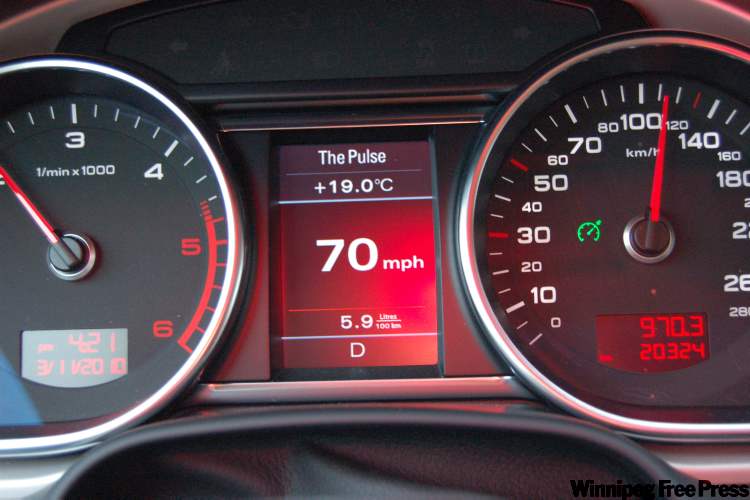AUTO TECH: Instrument clusters more like computers
Advertisement
Read this article for free:
or
Already have an account? Log in here »
To continue reading, please subscribe:
Monthly Digital Subscription
$1 per week for 24 weeks*
- Enjoy unlimited reading on winnipegfreepress.com
- Read the E-Edition, our digital replica newspaper
- Access News Break, our award-winning app
- Play interactive puzzles
*Billed as $4.00 plus GST every four weeks. After 24 weeks, price increases to the regular rate of $19.00 plus GST every four weeks. Offer available to new and qualified returning subscribers only. Cancel any time.
Monthly Digital Subscription
$4.75/week*
- Enjoy unlimited reading on winnipegfreepress.com
- Read the E-Edition, our digital replica newspaper
- Access News Break, our award-winning app
- Play interactive puzzles
*Billed as $19 plus GST every four weeks. Cancel any time.
To continue reading, please subscribe:
Add Free Press access to your Brandon Sun subscription for only an additional
$1 for the first 4 weeks*
*Your next subscription payment will increase by $1.00 and you will be charged $16.99 plus GST for four weeks. After four weeks, your payment will increase to $23.99 plus GST every four weeks.
Read unlimited articles for free today:
or
Already have an account? Log in here »
Hey there, time traveller!
This article was published 13/08/2010 (5553 days ago), so information in it may no longer be current.
INSTRUMENT clusters appear much the same as they did in the 1970s. Styling is different, and there are a few more warning lights, but the speedometer, tachometer and fuel gauge are still there. Some vehicles have oil pressure gauges, temperature gauges, voltmeters and warning lights, just as some vehicles did decades ago.
But while the basic functions appear similar, instrument-cluster operation is now very different, becoming an integral part of many vehicle communications networks.
Let’s start with a simple example — the speedometer. Old-style speedometers have a mechanical speedometer cable, driven by a gear in the transmission. The cable is attached to the back of the speedometer head where it spins a housing with a couple magnets attached. These magnets spin closely to another disc that is rotated by the spinning magnetic attraction. As the disc rotates, it moves the speedometer needle, which is returned to zero by a small spring.

Modern vehicles use electric speedometers. A voltage pulse from a sender on the transmission typically goes to the engine computer where it is used for everything from modifying the amount of fuel injected to timing the transmission shift points. The engine computer also sends the speedometer information down the data line to all the other computers than may use it.
Think of data lines just like an old style party phone line. Information can be passed back and forth on the line while every computer can listen in. It can use the information if needed. The instrument cluster is really a computer module itself and it uses the speed data to operate the speedometer.
There are two types of electronic speedometers commonly in use. One uses a small electric motor that spins magnets, just like the old mechanical units. The electronics in the instrument cluster vary the speed of the electric motor so the gauge needle changes. The other style of electric speedometer uses two electromagnetic coils to pull the needle back and forth. By varying the strength of the magnets, the gauge reads different speeds.
Tachometers operate virtually the same way as speedometers, and those analog gauges for fuel, temperature and oil pressure are really electronic units operated by the instrument cluster as it receives data down the communications network.
Warning bulb operation is different too. In the old clusters, the bulb often received battery voltage from the cluster and it was directly wired to a sender unit that would ground the circuit to illuminate the bulb. Now almost everything is controlled electronically, with the instrument cluster providing both power and ground. When you turn the key on, all the warning bulbs are turned on. Once the vehicle is started, the instrument cluster monitors the data line and once it receives a data signal that a system is OK, it will turn the bulb off.
For example, for the ABS and traction control indicators to be turned off, the cluster must get an OK signal from the ABS computer, and for the airbag light to be turned off, the proper signal must come from the restraints system computer. Every few seconds, the computers keep sending this OK signal down the data line, so the Instrument cluster keeps the bulbs off. If the signals stop, the warning light comes on in a few seconds.
Electronic odometers are also used. Some that have mechanical-style readouts use an electric motor to turn the mileage indicators, just like the electronic speedometers. Many vehicles use digital odometer and trip meter displays. A microchip in the instrument-cluster circuitry stores the vehicle mileage even if the power is disconnected to the vehicle.
It’s possible to install a used cluster and on some vehicles and this will change the displayed mileage, but a repair shop is supposed to indicate the original mileage on a sticker so the next owner will know the correct total. Other vehicles store the mileage in other computers too, so on some, a technician can read the vehicle mileage with a scan tool. If you send your instrument cluster away for repair, the repair shop can program your original mileage into the replacement cluster on most vehicles.
The next time you look at your vehicle’s gauges, imagine that there is a computer behind the faces, some as powerful as the one on your desktop. They may look the same, but new vehicle instrument clusters certainly operate differently.
Jim Kerr is an experienced mechanic, instructor and member of the Automobile Journalists’ Association of Canada.
kerr.jim@sasktel.net

